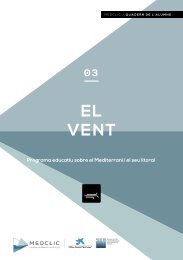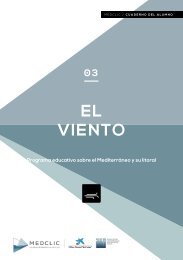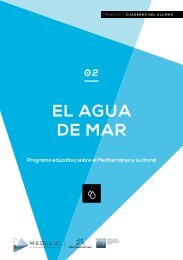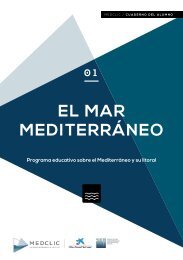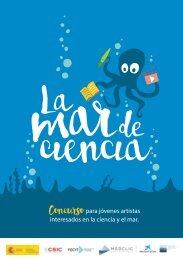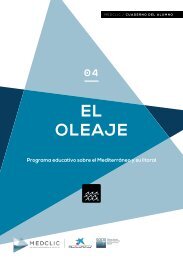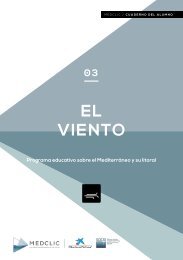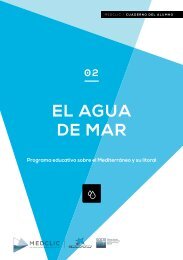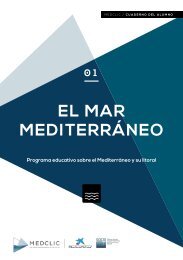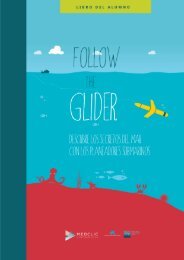LIBRO DEL ALUMNO ENG 7
Create successful ePaper yourself
Turn your PDF publications into a flip-book with our unique Google optimized e-Paper software.
Follow the Glider is an educational tool developed by CEFAS (Centre for<br />
Environment, Fisheries & Aquaculture Science), IMEDEA (Mediterranean<br />
Institue for Advanced Studies, CSIC-UIB), and SOCIB (Balearic Islands<br />
Coastal Observing and Forecasting System) as part of the FP7–JERICO<br />
European project, and is based on the glider monitoring tool that is<br />
avaliable at www.socib.es and has been adapted for student use at<br />
www.followtheglider.com.<br />
Medclic: the Mediterranean just a Click Away project, jointly produced by “la Caixa” Foundation<br />
and SOCIB..<br />
Direction<br />
Àngels Garau<br />
Tomeu Canyellas<br />
Joaquín Tintoré<br />
Coordination<br />
Àngels Garau<br />
Tomeu Canyellas<br />
Alberto Jarabo (Quindrop Producciones Audiovisuales)<br />
Contents<br />
Marta Hierro (MOM Works)<br />
Àngels Garau<br />
Art direction & ilustration<br />
Luis Ozonas (Ozonas Disseny Gràfic)
TABLE OF CONTENTS<br />
1. What is a glider? ............................................................................................ 2<br />
2. How does it work ........................................................................................... 5<br />
3. What does it measure ................................................................................7<br />
4. What is it for ..................................................................................................10<br />
5. Explore the ocean ........................................................................................11<br />
6. Activities.. ........................................................................................................ 12<br />
Discover a Glider and Follow It ........................................................... 12<br />
Your Glider Mission .................................................................................... 13<br />
Building a Glider ..........................................................................................16<br />
The Amazing Story of the Floating Egg<br />
and the Colored Ice Cubes .....................................................................18<br />
The Water Layer Trick ................................................................................19<br />
The Thermocline: a Transition Zone .................................................21<br />
The Ocean’s Smallest Creatures .........................................................23<br />
The Fisherman ...............................................................................................25<br />
And Yet It Moves ..........................................................................................28<br />
A Fabulous Team .......................................................................................... 31<br />
7. Glossary .. .........................................................................................................33<br />
1
1. WHAT IS A GLIDER *<br />
An underwater glider is a small submarine that’s autonomous–which<br />
means there’s nobody inside it, one reason being that nobody could<br />
possibly fit in there: it’s only about 2 meters long and weights around<br />
50 kilos.<br />
Underwater gliders are used to observe the seas and the oceans. Scientists<br />
place them in the water and the gliders collect interesting data<br />
about the temperature, the amount of salt and oxygen in the water, and<br />
so forth. They do so by using sensors that measure that information<br />
and much more (depth, etc.)<br />
1<br />
2<br />
Interesting info<br />
They use very little energy<br />
because they glide; they<br />
don’t have any engines or<br />
propellors.<br />
They can dive as deep as<br />
1000 meters.<br />
3<br />
4<br />
They can go as fast as 10-20<br />
centimeters per second in vertical<br />
motion, but if the currents help them<br />
along, they can go up to 1 kilometer an<br />
hour.<br />
They can send data to the lab<br />
through their antennas, and<br />
receive data, too<br />
RUDDER *<br />
It steers the glider in a<br />
given direction.<br />
Science bay *<br />
This is the part of the processor in charge of the<br />
scientific sensors<br />
Look, this is what a<br />
glider looks like on<br />
the inside!<br />
ANTENNA<br />
It allows the glider to send<br />
data to the lab, and receives<br />
information for making any<br />
necessary adjustments to<br />
the mission.<br />
Piston<br />
It fills up and releases water, making the<br />
glider dive down or come up. When it fills<br />
up, down goes the glider. When it empties<br />
out, that space fills up with air and makes<br />
the glider float to the surface<br />
Watch the vídeo<br />
http://followtheglider.socib.es/en/<br />
estudiantes/whatisaglider/<br />
BLADDER<br />
It’s very close to the antenna. When the glider<br />
comes up to the surface, the bladder fills up<br />
with air. This lifts the glider’s tail so the waves<br />
won’t cover the antenna, enabling it to send<br />
and receive data without interference.<br />
NAVIGATION<br />
BAY *<br />
This is the part of the processor in charge<br />
of the glider’s navigation device<br />
WINGS<br />
They enable the<br />
glider to advance<br />
underwater.<br />
SENSORS *<br />
They are used to measure<br />
water temperature, salt<br />
content, chlorophyll, oxygen,<br />
the distance from the sea floor,<br />
etc<br />
Batteries<br />
They can be lithium or alkaline batteries,<br />
and provide power for the glider. The<br />
batteries also move back and forth inside<br />
the glider. If they move forward, they help<br />
it sink. If they move backward, they help<br />
it go up.<br />
2 3<br />
* Look in the glossary the words with a red asterisk
Pros and cons<br />
There are other ways of getting data about the sea. One of them is organizing<br />
an expedition with several scientists, hopping on a boat, and<br />
sailing off for a few days, weeks, or even months to take all kinds of<br />
measurements. What are the advantages and disadvantages of using<br />
underwater gliders instead of other systems like boats?<br />
ADVANTAGES<br />
DISADVANTAGES<br />
2. HOW DOES IT WORK<br />
How does it go up and down in the water?<br />
1. An underwater glider has a piston.<br />
When it wants to dive down, it fills the<br />
piston up and sinks.<br />
2. When it wants to come back up to the<br />
surface, it releases the water from the<br />
piston.<br />
Watch the vídeo<br />
3. The space that held the water fills up<br />
with air, and that makes the glider rise.<br />
4. It’s like an inflatable rubber ring: when<br />
it’s full of air, it floats, and when it isn’t,<br />
it sinks.<br />
http://followtheglider.socib.es/en/estudiantes/howitworks/<br />
They work 24 hours a day, 7 days a<br />
week.<br />
They cover large distances.<br />
They can go on long-term missions.<br />
They’re autonomous, unmanned<br />
systems, so you don’t need a large<br />
number of people on board, as you<br />
would on a boat. Therefore, they’re<br />
much cheaper!<br />
They can include many different<br />
sensors to measure many kinds of<br />
data (temperature, salinity*, chlorophyll*,<br />
oxygen... even sounds!)<br />
They allow us to collect almost real-time<br />
data.<br />
They move very slowly.<br />
They can only go down 1000 meters.<br />
They can’t go any deeper!<br />
They can’t take samples on the spot.<br />
They don’t have an arm that can take<br />
sand or water samples, for example.<br />
They can only collect data!<br />
Their sensors are still quite low-resolution<br />
compared to the ones available<br />
on boats.<br />
Their technology is very recent.<br />
They’re still in the prototype stage, so<br />
things don’t always work properly.<br />
Watch out! Danger! They can run into<br />
fishing nets, plastic objects, or collide<br />
with the sea floor or boats.<br />
A glider’s journey, step by step.<br />
Lab<br />
The scientist decides on the glider’s mission<br />
and the engineer, who’s also the pilot,<br />
inputs the data into its operating system:<br />
route, deepest dive, how often it will get in<br />
touch with the base, what data it will collect<br />
and how often, what information to transmit,<br />
etc.<br />
Launching and<br />
navigating<br />
Once we’ve put the glider in the water,<br />
first it sinks and then it bobs back up.<br />
During the entire mission, it keeps on going<br />
up and down like this. As it sinks and<br />
surfaces, it collects data. A set of alkaline<br />
or lithium batteries provide the power it<br />
needs to move. It doesn’t have propellers<br />
or a motor, so it doesn’t use up a lot of energy.<br />
Okay, so... how does it move along?<br />
It does so by using its wings. When the<br />
glider goes up and down, it glides in the<br />
water. If it has to change course*, it uses<br />
the rudder attached to its tail.<br />
4<br />
Data transmission<br />
The glider comes up to the surface, connects<br />
its antenna, and sends the data it<br />
has collected via satellite. If necessary, it<br />
receives new orders. Its GPS* helps it find<br />
its way, detects whether the currents have<br />
set it off course*, and points it in the right<br />
direction.<br />
5
How long do the batteries last?<br />
A glider doesn’t have a motor,<br />
so it uses as little battery power<br />
as a cell phone. It gets the power<br />
it needs from alkaline or lithium<br />
batteries.<br />
Well, that depends on…<br />
•<br />
The type of battery: lithium batteries last longer.<br />
•<br />
The environment: gliding against the current uses<br />
more power.<br />
•<br />
The mission: if the glider has to dive down deep,<br />
turn on many sensors, or send data many times a<br />
day, it uses more power.<br />
3. WHAT DOES IT MEASURE<br />
An underwater glider measures different things in the seawater: some are<br />
physical (the amount of salt, the temperature) and others are biochemical<br />
(the amount of oxygen or chlorophyll in the water).<br />
Physical parameters: salt and temperature<br />
What happens if it goes off course*?<br />
Ocean currents can set a glider off course.<br />
When it realizes what’s going on, the glider<br />
can correct its “mistake”: for example,<br />
if it thinks there have been currents heading<br />
south, it will head further north to correct<br />
that divergence<br />
End of the mission<br />
The mission ends because...<br />
•<br />
That was the way it was planned all<br />
along.<br />
•<br />
Something very serious happens, like<br />
a mechanical failure.<br />
The batteries run out.<br />
•<br />
If a storm is coming, we give the glider<br />
the order to dive down, avoid the<br />
storm, and wait until it passes to continue<br />
its mission. But if there’s a long<br />
stretch of bad weather ahead... we’ve<br />
got to recover the glider right away!<br />
Do you think the amount of salt in the water is the same everywhere in the<br />
sea? And that the temperature is the same, too? Well, it isn’t!<br />
The water that flows into the Mediterranean from the Atlantic Ocean through<br />
the straits of Gibraltar contains less salt. Meanwhile, the water in the eastern<br />
Mediterranean is saltier. Why do you think it is? In the eastern Mediterranean,<br />
there’s more evaporation, and if more water evaporates, the<br />
proportion of salt left in the water is higher.<br />
And why would Seawater is not the same on the surface and down deep. On the<br />
we want to know surface, it’s not very dense. Density depends on salt and temperature,<br />
among other things. So when we measure its temperature<br />
about the water’s<br />
temperature and and salinity, we find out about the changes in the water’s density.<br />
salt content? These changes affect marine currents: if we have that information,<br />
we can find out more about how currents move.<br />
We can also find out more about the weather’s influence on the sea.<br />
For example, if it rains, the surface water cools down. If the weather’s very<br />
hot, the surface water warms up. That also has an effect on marine currents.<br />
Coming home<br />
With any luck, the glider will make it home on its own. But that may use up a lot of battery<br />
power, so we have to figure it all out very well in advance, so the glider won’t end up<br />
stranded.<br />
Sometimes it’s worth continuing to collect scientific data even if a glider’s batteries have<br />
run out. In this case, when the power is all used up, we set out to find the glider, wherever<br />
it may be. And that isn’t always easy!<br />
We´ve got a problem!<br />
There are many dangers out there<br />
while a glider’s on a mission:<br />
DANGERS:<br />
Mechanical or software failures.<br />
Collisions with boats, fishing nets, and buoys…<br />
Poor-quality batteries.<br />
Biochemical parameters*: oxygen and chlorophyll<br />
The oxygen and chlorophyll* in seawater are very important for marine<br />
ecosystems. Oxygen is what most animals and plants need to survive. And<br />
chlorophyll helps us know how much phytoplankton the water contains.<br />
Phytoplankton is made up of small organisms (like tiny algae) that photosynthesize<br />
and have chlorophyll. So, if there’s a lot of chlorophyll in the water,<br />
it means there’s lots of phytoplankton. Do you think that’s important? It<br />
sure is, because many marine animals feed on phytoplankton! Phytoplankton<br />
also absorb large amounts of CO2; they’re like a forest in the sea, the<br />
“ocean’s lungs.”<br />
6<br />
!<br />
If any of this<br />
happens, we have<br />
to suspend the<br />
mission and rescue<br />
the glider!<br />
Communications failures because of the glider<br />
itself or the satellites.<br />
Low-density waters that don’t allow the glider<br />
to get back up to the surface.<br />
Unwanted fellow travelers, such as mollusks<br />
or remoras*, that stick onto the glider and stop<br />
it from moving on.<br />
* Look in the glossary the words with a red asterisk<br />
7
How do we read the data we receive from a glider?<br />
We use the data we receive from a glider to put together charts. They seem<br />
hard to read, but it’s actually easier than you think.<br />
This is a salinity chart, showing how much salt is in the water. The water<br />
with more salt is shown in red and the less salty water is blue.<br />
SURFACE<br />
SALINITY<br />
Water<br />
with less<br />
salt<br />
SURFACE<br />
CHLOROPYLL<br />
Water<br />
with more<br />
chlorophyll<br />
DEPTH<br />
(in metERs)<br />
DistancE<br />
(in kilOmetErs)<br />
Greatest depth<br />
reached by the<br />
glider<br />
The more salt there is in<br />
the water, the heavier it<br />
becomes (it's denser).<br />
Since it's heavier, it goes<br />
down to the bottom.<br />
That's why deep water is<br />
saltier (red) than water<br />
near the surface (blue).<br />
In this chart, the water is<br />
saltiest near the surface<br />
(see the little red dot?).<br />
That's because a lot of<br />
water has evaporated<br />
(because it's in the sun)<br />
and the salt concentration<br />
is very high right here.<br />
Since salt makes water<br />
heavier (denser), it makes<br />
it go down to the bottom,<br />
leaving the less saline<br />
water (blue) on the<br />
surface.<br />
SALINITY<br />
Water<br />
with more<br />
salt<br />
DEPTH<br />
(in metERs)<br />
DistancE<br />
(in kilOmetErs)<br />
The sea contains chlorophyll<br />
because of phytoplankton<br />
(microscopic algae). These tiny<br />
plants use their chlorophyll to<br />
photosynthesize. They also need<br />
the sunlight to do so. That is why<br />
chlorophyll concentrates near the<br />
sunlit surface (red).<br />
In deeper water, below the sunlit<br />
layer, phytoplankton are unable to<br />
survive. They need sunlight in order<br />
to photosynthesize and feed themselves.<br />
That is why there is less<br />
chlorophyll in these areas (blue).<br />
CHLOROPYLL<br />
Water<br />
with less<br />
chlorophyll<br />
This is a chart showing the sea’s temperature: each column shows the glider’s<br />
course over several kilometers. Some columns are deeper than others. That’s<br />
because the glider doesn’t always reach the same depth. You know why? Because<br />
the sea floor isn’t flat. Sometimes there are mountains, and the glider<br />
can’t go any deeper: it would crash against the bottom.<br />
This is an oxygen concentration chart, showing how much oxygen is in<br />
the water. The water with more oxygen is shown in red and the water<br />
with less oxygen is green and blue.<br />
SURFACE<br />
DEPTH<br />
(in metERs)<br />
DistancE<br />
(in kilOmetErs)<br />
water temperature<br />
The glider hasn't<br />
gone down very<br />
deep because the<br />
water's shallow.<br />
In this column,<br />
the glider has<br />
gone down<br />
quite far.<br />
On the surface,<br />
the water is red<br />
or yellow because<br />
it's warmer (from<br />
the sunlight).<br />
Down deep, the column is<br />
blue because the water is<br />
colder (no sunlight).<br />
If a glider moves<br />
through an area where<br />
it's been raining, the<br />
surface water may also<br />
be very cold, so it's<br />
marked in blue on the<br />
chart. One of the things<br />
that can cool the sea<br />
down is a major storm.<br />
Warmer<br />
water<br />
TEMPERATURE<br />
Colder<br />
water<br />
SURFACE<br />
DEPTH<br />
(In metERs)<br />
DistancE<br />
(in kilOmetErs)<br />
OXYGEN<br />
Near the water's surface, the<br />
oxygen concentration is<br />
very high (red) because it's<br />
in contact with the atmosphere<br />
and because phytoplankton<br />
(microscopic<br />
algae) photosynthesize,<br />
releasing oxygen.<br />
Further down, the waters contain less oxygen<br />
(green and blue). In this area, the oxygen<br />
content is very low. If we go a bit further down,<br />
waters have a slightly higher oxygen<br />
content because they come from cold surface<br />
that have trapped oxygen and dragged it down<br />
deep. But they never contain as much oxygen<br />
as the water near the surface!<br />
Water<br />
with more<br />
oxygen<br />
oxygen<br />
Water<br />
with less<br />
oxygen<br />
8<br />
9
4 WHAT is IT FOR 5<br />
EXPLORE the ocean<br />
We’re used to seeing how weather works, with its high- and low-pressure<br />
areas, its storms, and so forth. Things are pretty much similar in<br />
the sea, and it’s important to know how currents and whirlpools work<br />
in order to come up with forecasting models. These models enable us<br />
to do things such as:<br />
•<br />
Know in what direction an oil spill is going to move. If we<br />
know where it’s heading, we can try to contain it so that it<br />
does the least possible damage to the environment.<br />
Know how the oceans are reacting to climate change.<br />
•<br />
Know how severe winter storms affect the sea. These extreme<br />
phenomena can have an impact on marine ecosystems.<br />
•<br />
In the future, gliders will have more advanced sensors<br />
that will allow us to measure nitrites, nitrates, pH, alkalinity,<br />
etc. This will allow us to take better care of our Marine<br />
Protected Areas, among other things*.<br />
WHERE ARE OUR GLIDERS SAILING TODAY?<br />
FOLLOW THEM AT WWW.FOLLOWTHEGLIDER.COM<br />
The www.followtheglider.com Gliders<br />
The gliders you see on this website are the ones we use in the area<br />
around the Balearic Islands. This area is an important crossroads between<br />
the waters of the Gulf of Lion, to the north, and the Alboran Sea<br />
to the south. The channels of Ibiza and Mallorca let in water with lower<br />
salinity coming from the Atlantic Ocean, which mixes with saltier water<br />
coming from the currents of the northern Mediterranean Sea. The<br />
crossing of these currents makes the waters much richer in nutrients,<br />
with a high concentration of larvae from many species, such as bluefin<br />
tuna.<br />
We need to find out how it all works so we can preserve this wealth.<br />
That’s what gliders are for. Before they existed, scientists went out on<br />
boats several times a year to take measurements. In winter, bad weather<br />
made it harder and considerably more expensive. Now, thanks to<br />
gliders, we have much more information that has helped us find out<br />
that changes in the main currents happen faster than we had imagined.<br />
10 11<br />
* Look in the glossary the words with a red asterisk
1 ACTIVIty<br />
ACTIVITY 2<br />
Discover a glider<br />
and follow it<br />
Your Glider Mission<br />
You’re a glider pilot and have to make a few decisions.<br />
1. Do you have to put gasoline in the glider before it leaves?<br />
* Before you answer, look at the “Setup and Programming” microvideo<br />
that you will find at www.followtheglider.com, under<br />
Teachers/Additional material.<br />
4<br />
2<br />
* You can also look at the “How it works” section in the STUDENT<br />
BOOK and on the website.<br />
a. No, you don’t. The glider doesn’t need any gasoline because it glides<br />
and uses batteries.<br />
b. Yes, it needs gasoline so it can go up and down in the sea..<br />
3<br />
5<br />
1<br />
2. The glider has gone off course. What should you do?<br />
* Before you answer, watch the “Monitoring” micro-video that you<br />
will find at www.followtheglider.com, under Teachers/Additional<br />
material.<br />
* You can also look at the “How it works” section in the STUDENT<br />
BOOK and on the website.<br />
a. Just let it keep on going.<br />
b. Send it new data so it can get back on the right course.<br />
c. Go fetch it before it gets lost.<br />
3. The glider is very far from home. It’s collecting really interesting<br />
data, but it’s almost out of battery power. What are your options?<br />
a. It’s probably not a big deal. Keep on going.<br />
b. Dive down deep and wait until the storm passes.<br />
c. Come home, it’s really dangerous!<br />
Piston<br />
Antenna<br />
Navigation bay<br />
Scientific bay<br />
Sensors<br />
1. Color the glider and label its<br />
parts.<br />
2. Choose one of the gliders that are<br />
on the “Explore” map and follow<br />
its course day by day.<br />
What do you see?<br />
How does the water temperature<br />
change?<br />
And the salt in the water?<br />
What clues do the chlorophyll<br />
and oxygen data give you?<br />
4. A storm is approaching. What orders should you send to the glider?<br />
a. It’s probably not a big deal. Keep on going.<br />
b. Dive down deep and wait until the storm passes.<br />
c. Come home, it’s really dangerous!<br />
12 13
5. The glider’s motor has broken down. What should you do?<br />
* Look at the diagram showing the parts of a glider in the “What is<br />
a glider?” section in the STUDENT BOOK and on the website.<br />
a. Send a mechanic out to repair it.<br />
b. That’s impossible. Gliders don’t have motors; they glide!<br />
6. The glider has sent you this graph showing the salt in the water.<br />
Point out where the following are.<br />
* Before you answer, look at<br />
the “Data Analysis” microvideo<br />
that you will find at www.<br />
followtheglider.com, under<br />
Teachers/Additional material.<br />
FEW THINGS YOU SHOULD KNOW BEFORE<br />
YOU CONTINUE WITH THE ACTIVITIES<br />
How does a glider move if it doesn’t have a motor?<br />
Gliders are very energy efficient, because they use small changes in buoyancy to move<br />
up and down in the water without the need for a motor or fuel. The submarine has a piston,<br />
and when it wants to go down, the piston lets seawater into the glider. This increases<br />
its density, so it sinks. The wings on its sides enable it to glide ahead like a plane. When<br />
the glider wants to go up to the surface, the piston pushes out the seawater, the glider’s<br />
density decreases, and it rises.<br />
Watch the video you’ll find at<br />
www.followtheglider.com,<br />
under “How it works.”<br />
* Check out the information about<br />
interpreting graphs and charts in<br />
the “What it measures” section<br />
in the STUDENT BOOK and on the<br />
website.<br />
a. The surface water.<br />
b. The bottom of the sea.<br />
c. The saltiest water.<br />
d. The least salty water.<br />
7. The glider is moving along on very warm surface water. Suddenly,<br />
it starts raining hard. What do you think will happen?<br />
a. The water on the surface will cool down.<br />
b. The water on the surface will stay just as warm.<br />
What is density?<br />
Density refers to how<br />
much mass there is in a cer<br />
tain volume. Even if two<br />
objects are the same size,<br />
if one has more mass than<br />
the other, it will be denser.<br />
For example, lead is denser<br />
than cork.<br />
How is density related to<br />
buoyancy?<br />
Buoyancy is an object’s<br />
ability to float in a liquid.<br />
One object will float above<br />
another one if it is less<br />
dense. The density of lead<br />
is 11.35g/cm3; it is 0.24g/<br />
cm3 for cork, and 1g/cm3<br />
for water. Therefore, cork<br />
will float on water, but<br />
lead will not.<br />
What is the density of<br />
seawater?<br />
The density of seawater<br />
varies according to its<br />
salinity and its temperature.<br />
Seawater is denser<br />
than freshwater; the saltier<br />
the water, the denser it<br />
is. Temperature also has<br />
an effect on density: cold<br />
water is denser than warm<br />
water. This de termines<br />
ocean circulations, which is<br />
the movement of masses of<br />
water within the ocean.<br />
8. The sea can be a very dangerous place for a glider. What dangers<br />
do you think it can encounter when it’s on a mission?<br />
* Before you answer, watch the “Rescue” micro-video that you<br />
will find at www.followtheglider.com, under Teachers/Additional<br />
material.<br />
9. What do you think gliders are for?<br />
Salinity<br />
Surface salinity depends primarily on evaporation and rainfall. In tropical zones, where<br />
evaporation is greater than rainfall, seawater is very salty on the surface. However, in<br />
coastal areas near the mouths of rivers, salinity is lower. At the Poles, when the ice melts<br />
during the summer season, salinity is also very low.<br />
Temperature<br />
The water temperature depends on the amount of heat absorbed from solar radiation<br />
and the amount of heat released from the sea to the atmosphere.<br />
14 15
3<br />
ACTIVIty<br />
Build a glider<br />
How does a glider move through water without a propeller?<br />
Let’s find out with the following experiment<br />
We are going to build a glider to see how changes in density make it move down and how<br />
wings make it glide ahead in the water.<br />
Read on the previous explanations about density, salinity, temperature, and buoyancy as<br />
they apply to gliders.<br />
MATERIALS REQUIRED<br />
A large fish tank filled with fresh water, coarse salt, kitchen scale, two 60cc syringes,<br />
Plexiglas, scissors, saw, hot glue or some other strong glue, yellow and black electrical<br />
tape, and one large measuring cup.<br />
CONSTRUCTION<br />
EXPERIMENT<br />
1. Fill the fish tank with fresh water to about ten centimeters from the top.<br />
2. Fill the large measuring cup about halfway with fresh water. Add a handful<br />
or two of salt and stir well. The salt should be large-grained and without<br />
special additives.<br />
3. Use the syringe to fill one of the gliders you built with the saltwater mixture.<br />
Hold it upright and press up on the plunger with your finger to remove any<br />
air bubbles.<br />
4. Have another one of the gliders you built empty or with a small amount of<br />
water inside it.<br />
5. Test fly the gliders by placing them horizontal in the tank (at the surface if<br />
it is water filled or near the bottom if empty/air filled) and giving a slight<br />
forward push before you release them. The glider should sink nose first, not<br />
tail first.<br />
Sinking should be this::<br />
And not this::<br />
1. First, cut the plunger of the syringe so it is about 2.5 cm long.<br />
2. Cut off any of the excess plastic at the back of the syringe. This modified<br />
syringe will form the body of the model glider.<br />
3. Next, form the glider wings by cutting 4 Plexiglas triangular shapes that are<br />
10 to 11.5 cm long and 3 cm high. Although real ocean gliders only have two<br />
wings, for stability this model needs four wings.<br />
4. Glue the wings to the syringe<br />
body at 90º angles at the<br />
positions north, south, east, and<br />
west. It is important to make<br />
sure that the wings are straight<br />
lengthwise on the tube, and as<br />
close as possible to a right angle<br />
on the syringe.<br />
5. Lastly, use yellow and black<br />
electrical tape to “paint” the syringe<br />
and make it look like a real<br />
glider.<br />
Floating should be this:<br />
6. Which of the gliders has a higher density?<br />
And not this:<br />
Activity written by Kate Florio, Liberty Science Center<br />
16 17
4 ACTIVITY 5<br />
The amazing story of the floating<br />
egg and the colored ice cubes<br />
ACTIVITY<br />
The water layer trick<br />
Read the previous explanations about density, salinity, temperature,<br />
and buoyancy before performing the following experiments.<br />
1 THE EGG THAT FLOATS... OR DOESN’T<br />
MATERIALS<br />
Two large, clear glasses, salt, water, and two raw eggs.<br />
EXPERIMENT<br />
1. Fill a large, clear glass with tap water and place a raw egg in it. What happens?<br />
2. Fill another identical glass with tap water and add a fair amount of salt. Stir<br />
it in. Place a raw egg in the glass. What happens?<br />
3. Why does one egg float and the other one sink?<br />
4. Why is saltwater denser than fresh water? Look for the answer online.<br />
How does seawater mix? Is seawater the same everywhere? Let’s<br />
find out with an experiment.<br />
Stratification<br />
In the ocean, masses of water form layers according to their densities. This is what<br />
we refer to as the water column, whose data the glider collects. In areas of open<br />
ocean, the water column usually has three different layers:<br />
1) At the top there is a layer of warm, less dense water.<br />
2) Next, there is a thermocline: an area where the water cools down and its density<br />
quickly increases with depth.<br />
3) Lastly, there is a deep layer of denser, colder water, whose density increases with<br />
depth.<br />
In the open ocean, the difference in density depends on temperature above all.<br />
However, in coastal areas near the mouths of rivers and in polar zones where<br />
ice forms or melts, salinity is very important for determining water density and<br />
stratification.<br />
35 grams<br />
Salty Water<br />
5. How do you think this affects the glider?<br />
If you have time, you can take the experiment one step further following<br />
this video: http://youtu.be/VAevsIHDnhQ<br />
1 Litre<br />
Fresh Water<br />
2. THE COLORED ICE CUBES<br />
Make ice cubes the day before. Into one half of the tray, pour<br />
food-colored water. Using a different color, pour very salty<br />
water into the other half of the tray (35 grams of salt per one<br />
liter of water, which is the average amount of salt in seawater).<br />
MATERIALS<br />
Fish tank or large, deep glass container, water, ice cubes made<br />
by the teacher with water, salt, and food coloring.<br />
EXPERIMENT<br />
1. Fill the fish tank with tap water. Allow the water a minute<br />
or two to settle.<br />
2. Gently add one cube of each color into the water. Before<br />
you do it, come up with a working hypothesis: what do<br />
you think will happen when you add the ice cubes?<br />
3. Describe and explain what happens.<br />
4. What ice cubes sink faster? Which sink slower? Why?<br />
Watch<br />
the vídeo<br />
MATERIAL<br />
Rectangular fish tank with a divider panel<br />
•<br />
Bottle of water with dissolved salt (about 75 grams<br />
of salt dissolved in 1 liter of water)<br />
Food coloring in two different colors<br />
Ice<br />
•<br />
Measuring cups<br />
EXPERIMENT<br />
EXPERIMENT 1<br />
1. Fill the measuring cup with tap water.<br />
2. Pour that tap water into one of the compartments in the<br />
divided tank. Pour the contents of the bottle with the saline<br />
solution into the other compartment.<br />
3. Add a few drops of food coloring of one color in one compartment<br />
and a few drops of another color into the other<br />
compartment.<br />
4. Generate a hypothesis: What do you think will happen<br />
when you remove the divider between the two compartments?<br />
Why? Which water is denser?<br />
5. Remove the divider. What happens? Is it what you expected?<br />
Salty water<br />
Food<br />
coloring<br />
Fresh water<br />
Food<br />
coloring<br />
18 19
6<br />
ACTIVITY<br />
The Thermocline: a transition zone<br />
EXPERIMENT 2<br />
We are going to repeat the experiment, but instead of using fresh water and saltwater,<br />
we will use cold water and warm water..<br />
1. Pour warm water into one compartment and cooled water into the other<br />
one.<br />
2. Put a few drops of food coloring of one color in one compartment and a few<br />
drops of another color in the other compartment.<br />
3. Come up with a hypothesis: What do you think will happen when you remove<br />
the divider between the two compartments? Why? Which water is<br />
denser?<br />
4. Remove the divider. What happens? Is it what you expected?<br />
Masses of water with different densities don’t mix, but what<br />
happens in the area where they meet?<br />
The Thermocline<br />
Waters with different densities don’t mix. They only do so if they’re affected by<br />
powerful external events, such as major storms. When the sun is very strong,<br />
the temperature on the ocean’s surface rises sharply. However, this temperature<br />
doesn’t reach the deepest water, which is colder (cold water is denser, so it sinks).<br />
Between the two layers, we find an area that separates both masses of water: that<br />
is the thermocline. When there is a big storm or a strong wind, the water is riled<br />
up, and the masses of water mix again in the surface. Look at how the thermocline<br />
works in the Mediterranean Sea throughout the year:<br />
winter<br />
spring<br />
summer<br />
fall<br />
Fresh warm water<br />
Cooled water<br />
Warm<br />
water<br />
Food coloring<br />
Food coloring<br />
Cooled<br />
water<br />
with ice<br />
DEPTH<br />
temperature profile<br />
thermocline<br />
agua salada<br />
agua thermocline salada<br />
agua salada<br />
strong<br />
thermocline<br />
thermocline<br />
+<br />
10º 20º 30º<br />
10º 20º 30º<br />
10º 20º 30º<br />
10º 20º 30º<br />
TEMPERATURE<br />
TEMPERATURE<br />
TEMPERATURE<br />
TEMPERATURE<br />
The Ibiza Channel<br />
There are places in the ocean where large masses of water come together, with<br />
different densities, temperatures, and salinities. This has consequences for the<br />
entire ecosystem and ocean climate in that location. One of those special places<br />
is the Ibiza Channel. Water masses from the Atlantic and the Mediterranean meet<br />
there, with the changes in density associated with temperature and salinity. Have<br />
a look at the following articles and you will see how the data provided by gliders<br />
help us learn how this confluence of waters works and what consequences it has for<br />
some animal species, such as the Atlantic bluefin tuna.<br />
Create your own thermocline<br />
Have you done the experiment in Activity 5? If so, remember the layer that appeared<br />
between the denser and the less dense water: that was the thermocline.<br />
If you haven’t done the experiment, watch this video and you’ll see where the<br />
thermocline is:<br />
Watch the vídeo<br />
http://youtu.be/RXTc-kHQN2U<br />
http://www.diariodeibiza.es/<br />
diario-verano/<br />
2013/01/04/<br />
biza-grifo-mediterraneo/<br />
597012.html<br />
http://www.diariodeibiza.es/<br />
diario-verano/2013/01/04/<br />
atunes-encuentranbalears-calor-necesitandesovar/597014.html<br />
Read the previous explanations about density, temperature, and buoyancy, as well<br />
as the information about stratification in Activity 5.<br />
1. If the water near the surface is very warm and the deep water is very cold, what<br />
time of year do you think it is? What will the thermocline be like? Why?<br />
20 21
7<br />
ACTIVITY<br />
The ocean’s smallest creatures<br />
2. Why do we say that the thermocline is a transition zone?<br />
3. How do storms affect the ocean?<br />
4. Look at the following graph. How would you interpret what happens in the summer?<br />
How can gliders help us learn about marine ecosystems?<br />
Gliders can’t collect samples of water that we can analyze in the lab, nor algae, nor<br />
sand from the ocean floor. However, they can supply us with certain data that enable<br />
us to draw conclusions about plankton. Plankton are a source of food for many<br />
living organisms, so if we analyze the data properly, we can determine how healthy<br />
a marine ecosystem is.<br />
What are Plankton?<br />
winter<br />
spring<br />
summer<br />
fall<br />
Plankton are aquatic plant and animal organisms, most very small, even<br />
microscopic, that drift in the water.<br />
Phytoplankton*<br />
DEPTH<br />
perfil de temperatura<br />
thermocline<br />
agua salada<br />
agua thermocline salada<br />
agua salada<br />
strong<br />
thermocline<br />
thermocline<br />
Phytoplankton are the kind of organisms that perform photosynthesis*. Most are<br />
microscopic algae. They stay near the surface of the ocean to receive sunlight, which is<br />
essential for them to photosynthesize and transform light into food. To trap the energy<br />
from sunlight, they need chlorophyll, and in doing so, they release oxygen. Gliders<br />
are capable of collecting data about chlorophyll and oxygen content, and therefore<br />
can tell us whether there are more or less phytoplankton in an area. Phytoplankton<br />
organisms are considered to be primary producers, and are a food source for very<br />
small organisms a well as for some very large ones, such as whales.<br />
Zooplankton<br />
+<br />
10º 20º 30º<br />
TEMPERATURE<br />
10º 20º 30º<br />
TEMPERATURE<br />
Concentration<br />
of nutrients<br />
10º 20º 30º<br />
TEMPERATURE<br />
Concentration<br />
of oxygen<br />
10º 20º 30º<br />
TEMPERATURE<br />
Zooplankton are very small or microscopic animals that live in the ocean. They do<br />
not only live near the surface, like phytoplankton; they spread out across all different<br />
layers. They are referred to as primary consumers, because they feed on primary<br />
producers–in other words, on phytoplankton. Small fish are secondary consumers<br />
because they feed on zooplankton. The larger fish, known as tertiary consumers, eat<br />
the smaller fish. This is the food chain, and it involves a huge energy transfer that<br />
begins with sunlight being turned into food.<br />
5. The data provided by gliders enable us to study the thermocline. Visit http://followtheglider.socib.es/explorar/.<br />
Choose one of the missions, click on one of the dots on<br />
its course, and then select Temperature. Point out where the thermocline is located<br />
in this graph.<br />
Phytoplankton *<br />
Primary<br />
producer<br />
Zooplankton<br />
Primary<br />
consumer<br />
Small fish<br />
Secondary<br />
consumer<br />
Large fish<br />
Tertiary<br />
consumer<br />
Carbon Sequestration<br />
When phytoplankton perform photosynthesis, they capture CO 2 and release oxygen.<br />
50% of the oxygen in the atmosphere is the result of this process.<br />
* Look in the glossary the words with a red asterisk<br />
22<br />
23
8<br />
ACTIVITY<br />
The fisherman<br />
1. At first glance, what kind of data would lead you to believe that there is a<br />
high concentration of phytoplankton in a given area of the ocean?<br />
2. Why are phytoplankton considered primary producers?<br />
3. Why are phytoplankton referred to as “the ocean’s lungs”? What consequences<br />
does this have?<br />
4. Why do you think the organisms that form phytoplankton are so light?<br />
5. Visit www.followtheglider.com and click on Explore. Choose a mission and<br />
look at the chlorophyll and oxygen graphs. Based on these data, say where<br />
you think the highest concentration of phytoplankton will be.<br />
6. How can gliders help us protect plankton?<br />
7. What would happen if a boat spills oil in the ocean? What consequences<br />
would it have for the food chain?<br />
8. Do you think that pollution and ozone depletion can have an effect on phytoplankton?<br />
Why?<br />
How can gliders help us learn about marine ecosystems?<br />
Can a glider help us find out in what areas there will be the greatest<br />
concentration of fish?<br />
The microscopic plants that make up phytoplankton need sunlight, nutrients, carbon<br />
dioxide, and water to grow. There is a lot of water and carbon dioxide in the ocean, but<br />
there is not always sunlight and nutrients. These two factors–sunlight and nutrients–<br />
determine the abundance of phytoplankton. Near the surface there is more sunlight,<br />
but nutrients are more abundant in the cold, deep waters near the ocean floor. How<br />
do phytoplankton manage to get both?<br />
Gliders provide us with graphs that help us find out where in the ocean these two factors<br />
converge, and where phytoplankton proliferate. Where you find phytoplankton,<br />
there is food for many organisms, and therefore you can assume that more species<br />
will be present in that area.<br />
Review the information about density, temperature, salinity, stratification, and phytoplankton<br />
provided in the previous pages.<br />
You are learning to be a fisherman and you need to find out where the fish are. You<br />
don’t know that much about fishing, but you do have a few very interesting graphs<br />
you got from a glider, showing the water temperature and the amount of chlorophyll.<br />
Answer the following questions to reach conclusions that will help you achieve your<br />
goal.<br />
. What are phytoplankton and what is their role in the food chain?<br />
2. Based on your answer to the previous question, come up with a hypothesis that<br />
will enable you to locate concentrations of fish. Consider the different factors that can<br />
have an effect on the proliferation of phytoplankton.<br />
3. Can a glider give us information about phytoplankton?<br />
24 25
4. It is the month of July. The glider is on a mission in the Mediterranean Sea, in the<br />
Ibiza Channel. It has sent us the following temperature and chlorophyll graphs. Observe<br />
and discuss the relationship between the two. In what area does the surface<br />
water nearest to the light meet with the deep, nutrient-rich water?<br />
Gyres and eddies, as well as storms, also contribute to breaking the thermocline and<br />
making nutrients rise to the surface, contributing to the proliferation of phytoplankton.<br />
Remember than in Activity 6 we said that the thermocline acted as a barrier between<br />
cold, deep, nutrient-rich water and the warmer water near the surface with fewer nutrients.<br />
If a storm or a eddy breaks the thermocline, the deep, nutrient-rich water is able<br />
to flow upward.<br />
This also occurs at a global level. At the Poles, when ice forms, the surface water becomes<br />
very salty, and therefore denser. This makes it sink down. And this downward<br />
motion in turn makes for an upwelling of deep, nutrient-rich water elsewhere. Look<br />
at the following map: the pink and blue areas are where the surface water sinks. Then<br />
the deep cold water flows into other areas and wells up to the surface: light green. This<br />
causes an upwelling, with a large amount of nutrients rising to the surface.<br />
Upwelling occurs when cold, dense, deep, nutrient-rich water flows up to the surface.<br />
Why does this water rise from the bottom? One of the causes is the wind on the surface<br />
of the ocean. When it blows on the surface, it creates a frictional force which, jointly<br />
with the Coriolis effect, makes the water from the surface flow towards the right (towards<br />
the left in the Southern Hemisphere). As it moves, this water is replaced by water<br />
from deeper layers, causing an upwelling. This causes an increase in phytoplankton,<br />
which benefit from the large amount of nutrients in the rising water.<br />
seaward flow of<br />
surface water<br />
wind<br />
warm,<br />
nutrient-poor water<br />
5. Do you think that a situation with riled-up waters is good for fishing?<br />
6. Do you think that the green areas in the map would be good for fishing?<br />
cold, nutrient-rich<br />
water<br />
* Look in the glossary the words with a red asterisk<br />
26 27
9<br />
ACTIVITY<br />
And yet it moves<br />
One of our gliders has drifted off the course it was supposed to<br />
follow. Why did this happen? What dragged it off?<br />
Although the ocean sometimes looks as if it were calm, it’s always on the move. The glider<br />
has gone off course because of the ocean currents.<br />
The wind blows on the<br />
surface and pushes the<br />
water<br />
The sun warms up the water. The warm<br />
water is less dense and stays near the surface,<br />
although it also evaporates and therefore its<br />
salinity increases.<br />
Surface Ocean Currents<br />
Surface ocean currents move 10% of the oceans’ water and move in the top 400 meters<br />
of the water column. They are usually moved by winds, creating a large-scale circulation<br />
system formed by five major ocean gyres. Due to the rotation of the Earth, everything<br />
that moves on the surface shifts towards the right in the Northern Hemisphere and towards<br />
the left in the Southern Hemisphere. Therefore, in the north, gyres turn clockwise,<br />
and in the south, counterclockwise. Look at the map of ocean gyres.<br />
Surface<br />
current.<br />
Related to<br />
weather and<br />
winds.<br />
Salt. The more salt it<br />
contains, the denser the<br />
water is. Saltier water<br />
sinks and makes the water<br />
move.<br />
1 The wind plays a part in creating surface currents. Let’s find out how with an<br />
experiment. Gather into groups of four.<br />
1. Fill a rectangular container with water (for example, a baking pan).<br />
2. One of the four students will stand at each corner of the container.<br />
Deep current. It is caused<br />
by the differences in the<br />
water’s density and the<br />
topography of the ocean<br />
floor.<br />
Topography of the ocean<br />
floor. It forms underwater<br />
valleys and mountains<br />
where the water flows.<br />
The Coriolis effect. The<br />
rotation of the Earth<br />
makes currents move to<br />
the right in the Northern<br />
Hemisphere and to the<br />
left in the Southern<br />
Hemisphere.<br />
3. Sprinkle black pepper onto the water in<br />
one of the corners.<br />
4. Each student will take a drinking straw<br />
and blow gently onto the water, towards<br />
the left. Each student will blow<br />
towards his or her left.<br />
What happens? How do you relate it to<br />
what happens in the ocean?<br />
28 29
10<br />
ACTIVITY<br />
A fabulous team<br />
Deep Currents<br />
Deep currents move 90% of the water in the<br />
ocean. Both salinity and temperature affect<br />
ocean circulation. The water that is denser<br />
(because it is colder or saltier) sinks, allowing<br />
its place on the surface to be replaced by less<br />
dense water. At the Poles, when ice forms, the<br />
water becomes less salty and therefore more<br />
dense. The water that sinks in the Arctic flows<br />
along the bottom of the ocean towards the<br />
Antarctic. There it splits and wells up again<br />
in the Indian Ocean and in the Pacific. On<br />
the ocean surface, the wind pushes the water<br />
toward the north Atlantic, where it sinks again.<br />
Look at this map of the Great Ocean Conveyor.<br />
The glider<br />
Discover the team that makes possible the missions of the gliders in SOCIB.<br />
To find out who is in charge of all the stages in a glider’s operation, watch the following<br />
micro-videos, which you will find at www.followtheglider.com, under Teachers/Additional<br />
material.<br />
1 Who decides where the glider goes? Look at the Planning video. What do<br />
you think of this job? Why do you think it is important?<br />
2. How do you prepare a glider before you put it in the water? Watch the Setup<br />
& Programming video. Do you think it’s complicated?<br />
3. How do you think you launch a glider into the water? Watch the Launching<br />
a Glider into the Sea video. Would you be able to do it?<br />
4. The glider is already sending data via satellite. Watch the Monitoring video.<br />
Try to do the same thing visiting www.followtheglider.com and clicking Explore.<br />
5. Now we have the data that the glider has sent us. Now what? Watch the Data<br />
Analysis video. How important do you think this job is?<br />
6. We have to go recover the glider! Watch the Rescovery video. What is the<br />
most interesting part of this job?<br />
2. Ocean currents move a lot of water and energy in the form of heat, and therefore<br />
they have an influence on the distribution of temperature around the planet. Look<br />
at the following map. The colors represent the water temperature: red for warm<br />
and blue for cold. How do you interpret it?<br />
7. Which of these jobs would you like best? Do you think they’re fun? Interesting?<br />
What studies would you have to follow to end up doing one of these<br />
jobs?<br />
More than Gliders<br />
SOCIB doesn’t only work with gliders. It also works with other technologies to obtain data<br />
that enable us to gain new insight into our seas and oceans, develop predictive models<br />
such as those for weather forecasts, etc. The data provided by gliders make it easier to<br />
control oil spills, protect marine resources, guarantee marine safety, etc. Visit the SOCIB<br />
website at www.socib.es and find out what the following elements are used for:<br />
Coastal HF radar<br />
Surface drifters<br />
Satellite<br />
Coastal research vessel<br />
Fixed stations<br />
Data center<br />
3. What would happen if these currents stopped moving and the warm water from<br />
the Equator did not reach the Poles, or the cold water from the Poles did not flow<br />
towards the Equator as it does now? Why could that happen? Come up with a hypothesis.<br />
4. How can gliders help us face this danger?<br />
30 31
How is all this research useful?<br />
For example, gaining new insight into the sea can help us prevent the effects of the meteotsunamis<br />
known as rissagues in Menorca. Watch the following video to find out what<br />
they are<br />
GLOSSARY<br />
http://www.socib.es/index.php?seccion=multimedia#current_video_title<br />
Watch<br />
the vídeo<br />
In what other ways do you think having so much information about the ocean is useful?<br />
GLIDER<br />
THE<br />
Biochemical parameters: biological and<br />
chemical variables that the glider measures<br />
during a mission, such as oxygen, chlorophyll,<br />
and turbidity.<br />
Chlorophyll: the pigment in green plants<br />
and certain bacteria that is involved in photosynthesis.<br />
Course: direction.<br />
Cyclone: an atmospheric disturbance that<br />
makes for strong winds.<br />
Glider: a small autonomous submarine<br />
used for observing ocean. These devices<br />
use wings and changes in flotation to achieve<br />
propulsion based on gliding, which uses<br />
very little energy.<br />
GPS: the acronym for Global Positioning System, which uses satellites to find<br />
a person or an object’s exact location in the world, with an accuracy of a few<br />
centimeters.<br />
High-pressure area: an atmospheric disturbance that usually brings clear<br />
weather (Anticyclone).<br />
Marine current: moving waters in a sea or an ocean.<br />
Marine Protected Area: a marine area specially designated for the protection<br />
and maintenance of its biological diversity and its natural and cultural resources.<br />
Navigation bay: the part of the glider’s processor in charge of the glider navigation.<br />
Photosynthesis: a process involved in the development of green plants and<br />
algae. These organisms use their chlorophyll to trap the energy they receive<br />
from sunlight, together with carbon dioxide from the air and the water. Photosynthesis<br />
enables plants to make their own food. In addition, plants produce<br />
oxygen as a byproduct of photosynthesis.<br />
32<br />
33
Phytoplankton: marine plankton, made up primarily of plant organisms<br />
such as microscopic algae.<br />
Physical parameters: physical variables that the glider measures during<br />
a mission, such as salinity, temperature, and water conductivity.<br />
Plankton: tiny animal and plant organisms that drift in the water.<br />
Remora: a species of fish, also known as suckerfish, which attaches itself<br />
to floating objects and large marine animals. In ancient times, people believed<br />
that remoras had the power to stop ships.<br />
Rudder: the part used to steer a boat (or in this case, a glider) in a given<br />
direction.<br />
Salinity: the amount of salt in seawater.<br />
Science bay: the part of a glider’s processor in charge of the scientific<br />
sensors.<br />
Sensor: a device that detects something external (temperature, pressure,<br />
etc.) and transmits that information.<br />
34<br />
35



